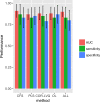Artificial intelligence and the analysis of multi-platform metabolomics data for the detection of intrauterine growth restriction
- PMID: 30998683
- PMCID: PMC6472728
- DOI: 10.1371/journal.pone.0214121
Artificial intelligence and the analysis of multi-platform metabolomics data for the detection of intrauterine growth restriction
Abstract
Objective: To interrogate the pathogenesis of intrauterine growth restriction (IUGR) and apply Artificial Intelligence (AI) techniques to multi-platform i.e. nuclear magnetic resonance (NMR) spectroscopy and mass spectrometry (MS) based metabolomic analysis for the prediction of IUGR.
Materials and methods: MS and NMR based metabolomic analysis were performed on cord blood serum from 40 IUGR (birth weight < 10th percentile) cases and 40 controls. Three variable selection algorithms namely: Correlation-based feature selection (CFS), Partial least squares regression (PLS) and Learning Vector Quantization (LVQ) were tested for their diagnostic performance. For each selected set of metabolites and the panel consists of metabolites common in three selection algorithms so-called overlapping set (OL), support vector machine (SVM) models were developed for which parameter selection was performed busing 10-fold cross validations. Area under the receiver operating characteristics curve (AUC), sensitivity and specificity values were calculated for IUGR diagnosis. Metabolite set enrichment analysis (MSEA) was performed to identify which metabolic pathways were perturbed as a direct result of IUGR in cord blood serum.
Results: All selected metabolites and their overlapping set achieved statistically significant accuracies in the range of 0.78-0.82 for their optimized SVM models. The model utilizing all metabolites in the dataset had an AUC = 0.91 with a sensitivity of 0.83 and specificity equal to 0.80. CFS and OL (Creatinine, C2, C4, lysoPC.a.C16.1, lysoPC.a.C20.3, lysoPC.a.C28.1, PC.aa.C24.0) showed the highest performance with sensitivity (0.87) and specificity (0.87), respectively. MSEA revealed significantly altered metabolic pathways in IUGR cases. Dysregulated pathways include: beta oxidation of very long fatty acids, oxidation of branched chain fatty acids, phospholipid biosynthesis, lysine degradation, urea cycle and fatty acid metabolism.
Conclusion: A systematically selected panel of metabolites was shown to accurately detect IUGR in newborn cord blood serum. Significant disturbance of hepatic function and energy generating pathways were found in IUGR cases.
Conflict of interest statement
The authors have declared that no competing interests exist.
Figures




References
MeSH terms
LinkOut - more resources
Full Text Sources
Medical
Miscellaneous

